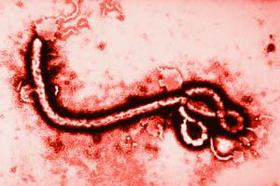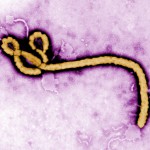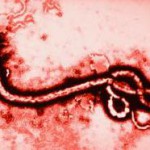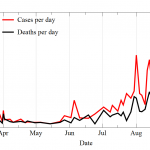Viral comments (13): Ebola, deadly virus but also touchable

It has been wrote, it is been writing and it will be written in the future about the Ebola Virus and its epidemic outbreak that it has take place in this exact moment that I’m writing this out of control lines, which it is especially affecting some East Africa countries. Although it has been approach its transmission method, little has been speak about the primary barriers and its disinfection and inactivation treatments. This post compiles, in non-exhaustive way, information on this field.
The Ebola virus is easily transmitted, but some few and cheap primary barriers can reduce a lot the risk if the work is been performed on field conditions or when taking care of the infected patients (Africa). This techniques includes wear a closed protective clothing (a coveralls), gloves, a mask filter and ocular protection (it is best if are safety goggles, although it is also valid the use of safety screens). Nevertheless, we must remember that risk “0” doesn’t exist, so the fact is that the first barrier and the one with more continued contact with the diseased people, above all those in the terminal phase, are the medical personnel which is, then, the main professional group affected by the Ebola’s infections. If the mask filters are replaced o completed with positive pressure systems, which must not be integral to the security, it will be increased, but it will required a maintenance and recharge of the equipment, something that can be quite complicated in field work conditions.
In field work conditions, before we take these protections off, we need to wash very well the gloves (the most exposed element) with water and soap. The gloves washed should be threw away (they should be disposables, it means, always single use only; in some cases it has been seen images of rubber gloves, kitchen type, drying in the sun in a campaign African hospital backyard after its disinfection; this is a “correct” practice, but mainly due to the economical constriction). Once the protective clothing is taken off, an intense and long hand wash with water and soap does the rest. If there is no soap, it may be used some antiseptic with an alcoholic basis.
In non-endemic areas (Europe, America) the manipulation is done, strictly, in BSL4 Laboratories (considering that it is a Group Risk 4, GR4, pathogen), this implies work with clothing seals with positive pressure and manipulation in biosafety cabinets. In the process to go out of the laboratory, the researcher receive a chemical shower that decontaminated the clothing (hydrophobic, waterproof, of course) before they take it off.
The Ebola virus can be lethal once infects someone, but the virus is very labile, very weak, when it has to suffer the actions from disinfectants, inactivating agents or, even from the environment.
The Ebola virus is an enveloped virus with ARN genome. Like all the enveloped viruses, with a membrane that comes from an infected cell, it is pretty sensible to the lipids solvents (detergents) and also to the oxidizing agents like the sodium hypochlorite (the house-hold bleach), the compounds from phenolics, methanol, peracetic acid, aldehydes such as glutaraldehyde (2%), formaldehyde and 3% of acetic acid solution (pH 2,5). The vinegar used to be between the 3% and the 4% of the acetic acid, for instance.
The Ebola virus is, also, quite sensible to the usual environment conditions or to the direct and “economic” inactivation physical treatment. For example, it can inactivate by boiling the liquid for 5 minutes, or heating up until 60ºC for 60 minutes, or until 75ºC for 30 minutes. Also it has been describe inactivation by UV light (therefore it is affected by solar radiation) or by gamma rays (by 1.2 x106 rads, and this is clearly an expensive technology). However, all that is an issue of probabilities, as a study of Sagripanti and contributors in 2011 demonstrates that depending on the time of UV light exposure, if it is until 30 seconds of exposure, 3%-4% of the occurring Ebola viruses kept their infectivity once they were associated and protected by the cellular debris. A more prolonged exposure would be surely more effective, but it wasn’t performed and quantified.
In the environment, the Ebola virus can persist infectious in liquids and desiccated over a surface for a few days, whereas most of the enteric virus of oral or fecal transmission can retain its infectivity for months. The infectivity remains stable for a few days if viruses are kept in refrigeration conditions (4ºC) and they maintain their infectivity unalterable at -75ºC (which it is the current storing method in the virology labs).
An effective respiratory protection, as well as preventing the contact between the virus contaminated materials and ours external mucosa and skin, it will avoid the contagion. Everything that is susceptible to be contaminated and we want to preserve is easily decontaminable (object by object and very carefully, it is a strong time consuming task). For the remaining items, the best and easy way to dispose should be house-hold bleach treatment or thermal treatment.
Leave to its fate in the environment, the Ebola viruses, by the combined action of the temperature (sun radiation), action of the UV rays (sun radiation), desiccation (wind and sun radiation again), microbial action and other parameters, don’t persist more than a few days or maybe a week. An outdoor contaminated area (in conditions of hard sunshine, high temperatures and low humidity) is “probably” safe without any intervention in a few weeks.
Although likelihood and safety doesn’t shake hands on all occasions.
But that, that’s another story.
Related document: A graphic made by El Mundo about How the Ebola infection evolves [in Spanish]













